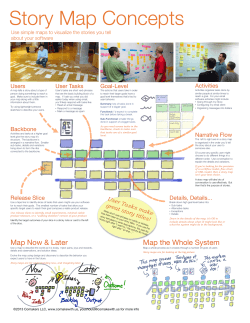
7.3 Finding Volume Using Cross Sections
7.3crossect 7.3 Finding Volume Using Cross Sections Warm Up: Find the area of the following figures: 1. A square with sides of length x 2. A square with diagonals of length x 3. A semicircle of radius x 4. A semicircle of diameter x 5. An equilateral triangle with sides of length x 6. An isosceles right triangle with legs of length x 7.3crossect 7.3crossect Previously, we used disk and washer methods to determine the volume of figures that had circular cross sections. Now, we will learn a method to determine the volume of a figure whose cross sections are other shapes such as semicircles, triangles, squares, etc. 7.3crossect Volumes with Known Cross Sections If we know the formula for the area of a cross section, we can find the volume of the solid having this cross section with the help of the definite integral. If the cross section is perpendicular to the x‐axis and itʼs area is a function of x, say A(x), then the volume, V, of the solid on [ a, b ] is given by If the cross section is perpendicular to the y‐axis and its area is a function of y, say A(y), then the volume, V, of the solid on [ a, b ] is given by Notice the use of area formulas in order to evaluate the integrals. The area formulas you will need to know in order to do this section include: Area of a Square = Area of a Triangle = Area of an Equilateral Triangle = Area of a Circle = 7.3crossect Volumes with known cross sections For each of the problems do the following: • Draw the region of the base of the solid. • Draw a representative slice of the solid with the correct orientation and note the thickness as dx or dy. • Draw the shape of the cross section. • Label the important measurements of the solid in terms of x or y looking at the base. • Write dV the volume of one representative slice using geometry formulas. • Write dV in terms of x or y. • Write the integral for the volume V, looking at the base to determine where the slices start and stop. • Use your calculator to evaluate. 7.3crossect Example 1) Consider a horizontal slice through the pyramid. What would it look like? How would we represent the A of that slice? How would we represent the Volume of the pyramid in differentials? dV = The volume of the slice is s2 dh 7.3crossect Example 2) Find the volume of the solid whose base is bounded by the circle x2 + y2 = 4, the cross sections perpendicular to the x-axis are squares. 7.3crossect Example 3) Find the volume if the cross sections perpendicular to the y-axis of a right triangle are semicircles. 4 y = 4/3x - 3 -3 7.3crossect Example 4) Find the volume of a solid whose base is bounded by the circle x2 + y2 = 4, the cross sections perpendicular to the x-axis are equilateral triangles. 7.3crossect Example 6) Find the volume of the solid whose base is bounded by y = x + 1 and y = x2 -1, the cross sections perpendicular to the x-axis are rectangles of height 5. 7.3crossect Example 5) Find the volume of the solid whose base is bounded by the circle x2 + y2 = 4, the cross sections perpendicular to the x-axis are right isosceles triangles with a leg on the base of the solid.
© Copyright 2025





















